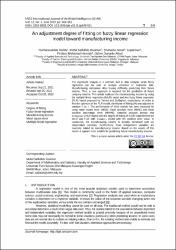An adjustment degree of fitting on fuzzy linear regression model toward manufacturing income

Göster/
Tarih
2023Yazar
Ramly, NurfarawahidaRusiman, Mohd Saifullah
Ismail, Shuhaida
Suparman
Hamzah, Firdaus Mohamad
Gürünlü Alma, Özlem
Üst veri
Tüm öğe kaydını gösterKünye
Ramly, N., M. S. Rusiman, S. Ismail, Suparman, F. M. Hamzah, and O. G. Alma. 2023. "An Adjustment Degree of Fitting on Fuzzy Linear Regression Model Toward Manufacturing Income." IAES International Journal of Artificial Intelligence 12 (2): 543-551. doi:10.11591/ijai.v12.i2.pp543-551.Özet
The regression analysis is a common tool in data analysis, while fuzzy regression can be used to analyze uncertain or imprecise data. Manufacturing companies often having difficulty predicting their future income. Thus, a new approach is required for the prediction of future company income. This article analyzed the manufacturing income by using the multiple linear regression (MLR) model and two fuzzy linear regression (FLR) model proposed by Tanaka and Zolfaghari, respectively. In order to find the optimum of the FLR model, the degree of fitting (H) was adjusted in between 0 to 1. The performance of three models has been measured by using mean square error (MSE), mean absolute error (MAE) and mean absolute percentage error (MAPE). Detailed analysis proved that Zolfaghari’s FLR model with the degree of fitting of 0.025 outperformed the MLR and FLR with Tanaka’s model with the smallest error value. In conclusion, the manufacturing income is directly correlated with six independent variables. Furthermore, three independent variables are inversely related to manufacturing income. Based on the results of this model, it appears to be suitable for predicting future manufacturing income.

















